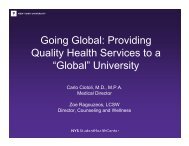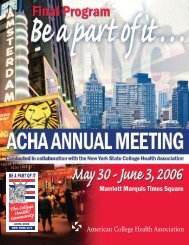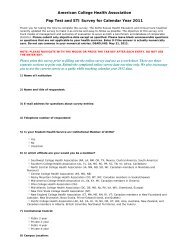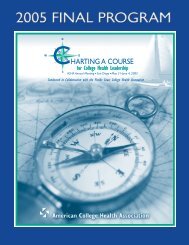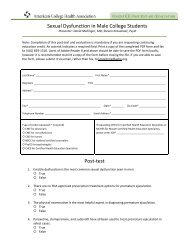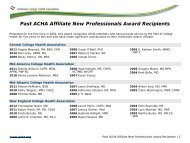Stimulant Misuse: Strategies to Manage a Growing Problem (.pdf)
Stimulant Misuse: Strategies to Manage a Growing Problem (.pdf)
Stimulant Misuse: Strategies to Manage a Growing Problem (.pdf)
- No tags were found...
Create successful ePaper yourself
Turn your PDF publications into a flip-book with our unique Google optimized e-Paper software.
USE AND MISUSE OF STIMULANTS<br />
REVIEW ARTICLE<br />
<strong>Stimulant</strong> <strong>Misuse</strong>: <strong>Strategies</strong> <strong>to</strong> <strong>Manage</strong><br />
a <strong>Growing</strong> <strong>Problem</strong><br />
Donald E. Greydanus, MD<br />
Professor<br />
Pediatrics and Human Development<br />
Michigan State University College of Human Medicine<br />
Kalamazoo Center for Medical Studies<br />
Sindecuse Health Center<br />
Western Michigan University<br />
Kalamazoo, Michigan<br />
Individuals diagnosed with attention-deficit/hyperactivity<br />
disorder (ADHD) as children are increasingly likely <strong>to</strong> continue<br />
receiving treatment—usually in the form of prescription<br />
stimulants—in<strong>to</strong> their later teenage and young adult<br />
years. In addition, many people are also diagnosed with the<br />
condition during their high school and college years, which<br />
has led <strong>to</strong> a growing controversy over the extent of prescription<br />
stimulant use for ADHD. These concerns revolve around<br />
the notion that greater access <strong>to</strong> prescription-grade stimulants<br />
in the general population has led <strong>to</strong> a greater potential<br />
for their misuse. This article reviews information about the<br />
use and misuse of stimulants among high school and college<br />
students and offers recommendations <strong>to</strong> school health officials<br />
on recognizing the signs and symp<strong>to</strong>ms of stimulant<br />
misuse, education on the risks and benefits of stimulant use,<br />
and opportunities for prevention of misuse.<br />
Approximately 4% <strong>to</strong> 10% of high school and college students<br />
suffer from attention-deficit/hyperactivity disorder (ADHD). 1,2<br />
Prescription stimulants (eg, methylphenidate or amphetamines)<br />
are the most common pharmacologic treatments for<br />
ADHD. <strong>Stimulant</strong>s are classified as Schedule II drugs (ie, providing<br />
positive medicinal effects but also considerable abuse<br />
potential). The Controlled Substance Act mandates that<br />
Schedule II drugs may only be used if the drug is provided by a<br />
prescription written and signed by a licensed practitioner, and<br />
also dictates that a refill is only permitted if the patient returns<br />
<strong>to</strong> the practitioner for further assessment. 3,4<br />
Recent observations and academic research suggest that inappropriate<br />
use of stimulants in adolescents and young adults,<br />
both with and without clinically diagnosed ADHD, is a growing<br />
concern. <strong>Stimulant</strong> misuse of these medications is often<br />
predicated on students’ misconceptions or a simple lack of<br />
knowledge on the associated risks. Indeed, many consider stimulants—whether<br />
obtained by prescription or illicitly—a convenient<br />
option <strong>to</strong> improve performance or <strong>to</strong> induce euphoria.<br />
There are 4 main types of stimulants used for the treatment<br />
of ADHD—the most commonly used options are amphetamines<br />
(mixed amphetamine salts immediate- and extendedrelease)<br />
and methylphenidate (osmotically-controlled<br />
release oral delivery system, diffucaps methylphenidate,<br />
spheroidal oral drug absorption system methylphenidate<br />
long-acting). Dextroamphetamine is another of the 4 main<br />
types of stimulants.<br />
Amphetamines. Amphetamine products have been used as<br />
medication since the early 1880s, and the abuse potential for<br />
these products has been observed and studied for nearly 100<br />
years. 5,6 Amphetamine misuse is considered <strong>to</strong> be principally<br />
related <strong>to</strong> the drug’s euphoria-inducing effects. 6 Users’ desire <strong>to</strong><br />
achieve euphoric effects frequently involves administration of<br />
high doses, which increases the risk for compulsive abuse. 7<br />
Chronic amphetamine abuse has been shown <strong>to</strong> result in malnutrition,<br />
paranoid schizophrenia-like mental illness, sleep<br />
deprivation, cerebrovascular accidents, and death. 6-9 Specific<br />
amphetamine disorders (eg, amphetamine dependence and<br />
amphetamine abuse) and amphetamine-induced disorders<br />
(eg, amphetamine in<strong>to</strong>xication, amphetamine withdrawal,<br />
amphetamine in<strong>to</strong>xication delirium) are described in the<br />
American Psychiatric Association’s (APA) Diagnostic and<br />
Statistical Manual of Mental Disorders, Fourth Edition, Text<br />
Revision (DSM-IV-TR) classification. 6,8-11<br />
ACHA PROFESSIONAL DEVELOPMENT PROGRAM 17
Table 1. DSM-IV-TR Criteria for Substance Dependence 11<br />
Meeting 3 or more of the following criteria classifies an individual as substance dependent<br />
• Tolerance<br />
• Withdrawal<br />
• More drug consumption than intended (in overt amounts or time of abuse)<br />
• Consistent longing or craving <strong>to</strong> control the abuse or failed attempts for control<br />
• Persistent drug use despite knowledge of its negative consequences<br />
• Spending excessive time in finding the drug or recovering from its use<br />
• Reduction in positive living (ie, less time in class or at work)<br />
DSM-IV-TR = Diagnostic and Statistical Manual of Mental Disorders, Fourth Edition, Text Revision.<br />
Methamphetamine, now infrequently prescribed for ADHD,<br />
has the greatest addiction potential of the stimulants and is<br />
currently difficult <strong>to</strong> obtain by prescription in many places in<br />
the United States. Methamphetamine and 3,4-methylenedioxymethamphetamine<br />
(MDMA) abuse has become a serious<br />
problem in many parts of the world, including the<br />
United States. 6-9 Street names for amphetamine include<br />
speed, meth, and chalk; names for methamphetamine<br />
include crank, fire, glass, meth, and chalk. 9 Street names for<br />
MDMA include ecstasy, dex, essence, diamonds, lover’s<br />
speed, Adam, X, bean, and others. 9<br />
Methylphenidate. The US Drug Enforcement Administration<br />
(DEA) has stated that methylphenidate confers a “high potential<br />
for abuse and produces the same effects as cocaine or the<br />
amphetamines,” and cases of oral, intranasal, and intravenous<br />
abuse of the drug are well documented. 3,12,13 Although misuse<br />
of methylphenidate is considered <strong>to</strong> be less common than<br />
that of amphetamines, methylphenidate misuse may be<br />
underreported. 13<br />
The notion of <strong>to</strong>lerance <strong>to</strong> methylphenidate remains controversial,<br />
and is usually described in those who have been taking<br />
the drug at high doses over a period of several months or years. 1<br />
There are no well-controlled studies examining methylphenidate<br />
<strong>to</strong>lerance; anecdotally, however, clinicians and<br />
patients describe situations where decreased efficacy of<br />
methylphenidate, in addition <strong>to</strong> psychological dependence,<br />
appears <strong>to</strong> occur. 14 Street names for methylphenidate include<br />
vitamin R, the smart drug, R ball, the cramming drug, and<br />
poor man’s cocaine. 9,15 Depression may develop in students taking<br />
amphetamines or methylphenidate, and those taking either<br />
of these medications should be moni<strong>to</strong>red for mood changes. 16<br />
The potential for misuse has made the prescribing of stimulant<br />
medications for the management of ADHD symp<strong>to</strong>ms in high<br />
school and college students an area of some controversy.<br />
Awareness of this potential risk has encouraged clinicians <strong>to</strong><br />
evaluate students presenting with ADHD symp<strong>to</strong>ms with a<br />
more critical eye so as <strong>to</strong> ensure appropriate ADHD diagnoses.<br />
In order <strong>to</strong> provide guidance <strong>to</strong> school health officials—who<br />
are responsible for addressing the needs of students with<br />
ADHD while discouraging misuse of stimulant medications—<br />
the remainder of this article will review information about the<br />
use and misuse of stimulants, offering recommendations <strong>to</strong><br />
school health officials on improved recognition of signs and<br />
symp<strong>to</strong>ms of stimulant misuse, and addressing student education<br />
on the risks and benefits of stimulant use, and opportunities<br />
for misuse prevention.<br />
Defining Substance <strong>Misuse</strong>, Abuse, and<br />
Dependence<br />
Initial misuse of a stimulant medication—taking a stimulant<br />
not prescribed by a physician or in a manner not in accordance<br />
with physician guidance—is frequently the prelude <strong>to</strong><br />
chronic abuse (ie, use of nonprescribed doses nearly every<br />
day) or <strong>to</strong> drug dependence. The APA’s DSM-IV-TR views<br />
substance abuse as a mental disorder involving the use of a<br />
substance <strong>to</strong> a point that induces considerable dysfunction in<br />
the life of the abuser. 11 In the life of a student, medication<br />
abuse may impair his or her ability <strong>to</strong> achieve maximal success<br />
in school and <strong>to</strong> maintain social relationships. Abuse may also<br />
continue unabated even as abuse-related issues worsen. Such<br />
issues may include falling grades or overt academic failure,<br />
increased violence, legal troubles, overdose, and other compounding<br />
complications.<br />
Dependence may be diagnosed if the abuser qualifies for at<br />
least 3 of 7 DSM-IV-TR criteria for substance dependence<br />
(Table 1). 11 As the abuser builds a <strong>to</strong>lerance <strong>to</strong> a substance, the<br />
usual drug dosage provides less of the desired effect and<br />
increased amounts of the chemical may be necessary <strong>to</strong> achieve<br />
the same effect, often compounding the negative physical<br />
effects of the drug and increasing the potential for overdose.<br />
Prevalence of <strong>Stimulant</strong> <strong>Misuse</strong><br />
Nonmedical use of prescription medications represents the<br />
second most common form of illicit drug use in the college<br />
population, second only <strong>to</strong> marijuana use and abuse. 17<br />
According <strong>to</strong> the University of Michigan’s Moni<strong>to</strong>ring the<br />
Future study, college students report a 5.7% rate of nonprescription<br />
methylphenidate use in contrast <strong>to</strong> 2.5% in noncol-<br />
18<br />
ACHA PROFESSIONAL DEVELOPMENT PROGRAM
USE AND MISUSE OF STIMULANTS<br />
Table 2. Reasons/Rationale Why Individuals <strong>Misuse</strong> Prescription <strong>Stimulant</strong>s<br />
• Achieve a euphoric state<br />
• Increase mental alertness<br />
• Increase energy level<br />
• Ease of obtaining these medications from peers or clinicians<br />
• Reduce the pressures of academic life<br />
• Seen as a part of a plan <strong>to</strong> improve poor grades<br />
• Unsolicited “gift” from other students (eg, for sex or friendship)<br />
• Belief that it is a safe practice<br />
• Selling these medications <strong>to</strong> make money<br />
• Consistent with a lifestyle of polypharmacy (illict and nonillicit)<br />
lege peers. 17 A 2001 study of 10,904 college students using selfreports<br />
identified a 6.9% lifetime prevalence of nonmedical<br />
prescription stimulant misuse, including a past-year prevalence<br />
of 4.1% and a past-month prevalence of 2.1%. 18 A recent study<br />
by Teter et al of 9161 undergraduates reported an 8.1% lifetime<br />
prescription stimulant abuse rate among college students,<br />
including 5.4% over the past year. 19 A smaller study found that<br />
out of 179 college males and 202 college females surveyed, 17%<br />
of males and 11% of females had engaged in illicit prescription<br />
stimulant misuse. 20 According <strong>to</strong> a 2002 survey of a single US<br />
college, 35.5% of undergraduates reported using stimulants<br />
without a prescription, with greater frequency occurring in<br />
males compared with females. 21<br />
Obtaining <strong>Stimulant</strong>s Through Illicit Means<br />
Amphetamine and methylphenidate products are acquired in a<br />
number of ways, such as from classmates, friends, clinicians, or<br />
through the Internet. School health officials should be aware<br />
that students misusing stimulant medications may employ various<br />
means <strong>to</strong> gain access <strong>to</strong> these medications, such as stealing<br />
pills from a teacher’s desk (when a teacher is chosen <strong>to</strong> dispense<br />
medication <strong>to</strong> students), making arrangements with or exerting<br />
pressure on a classmate who has a legitimately prescribed<br />
medication, or presenting symp<strong>to</strong>ms of ADHD at the college<br />
health center in an attempt <strong>to</strong> be prescribed a stimulant. 20,22 The<br />
DEA reported nearly 700,000 methylphenidate doses s<strong>to</strong>len in<br />
the United States in 1996 and 1997. 15<br />
The diversion of stimulants is very common and can begin in<br />
childhood, adolescence, or young adulthood. One survey<br />
reported that 23.3% of middle and high school students taking<br />
prescribed stimulants had been solicited <strong>to</strong> divert their medication<br />
<strong>to</strong> others at a rate that increased from middle school <strong>to</strong><br />
high school. 23 A review of 161 elementary and high school students<br />
prescribed the stimulant methylphenidate revealed that<br />
16% had been asked <strong>to</strong> give or sell their medication <strong>to</strong> others. 24<br />
A self-reported anonymous questionnaire administered <strong>to</strong> a<br />
random sample of Canadian students in grades 7, 9, 10, and 12<br />
found that of the 5.3% of students who had used a legitimately<br />
prescribed stimulant over the previous 12 months, 14.7%<br />
reported having given their medications <strong>to</strong> others, 7.3% had<br />
sold their medications <strong>to</strong> others, and 4.3% had their medications<br />
s<strong>to</strong>len. 25 Data have shown that the diversion continues<br />
among college students. 5,18 A recent survey of 334 college students<br />
who were prescribed stimulants for ADHD revealed that<br />
nearly 29% had sold or given their medication <strong>to</strong> others. 10<br />
Reasons for <strong>Misuse</strong><br />
The motives for misuse and abuse of stimulants are numerous<br />
(Table 2). Studies have shown that students with and without<br />
ADHD misuse these medications <strong>to</strong> achieve euphoria. 10,20<br />
According <strong>to</strong> a survey of 334 ADHD-diagnosed college students<br />
taking prescription stimulants, 25% misused their own<br />
prescription medications <strong>to</strong> get high. 10 Students may also use<br />
stimulants <strong>to</strong> help cope with stressful fac<strong>to</strong>rs related <strong>to</strong> their<br />
educational environment. Pressures such as a persistent desire<br />
<strong>to</strong> succeed academically, erratic and poor sleep habits due <strong>to</strong><br />
large workloads, and the persistence of underlying social and<br />
financial demands may place students at an increased risk for<br />
misuse of various drugs, including stimulants. 19,20,26 Students<br />
often assume these drugs are safe <strong>to</strong> use for improving their<br />
energy levels, increasing their capacity for concentration,<br />
enhancing school performance, or for recreational use, while<br />
lowering their desire for sleep. 26 <strong>Stimulant</strong>s are especially popular<br />
at the end of a school term when students will often use the<br />
drugs <strong>to</strong> stay awake through the night <strong>to</strong> study for exams or<br />
complete academic projects.<br />
Any type of student may misuse stimulants, but there may be<br />
an increased risk among students with low grade-point averages<br />
(or an average that falls below a student’s personal standards)<br />
or those at very competitive schools. 18 Athletes may see<br />
stimulants as a way <strong>to</strong> help maintain physical fitness for their<br />
competitive sport or <strong>to</strong> improve their concentration. 27 Men<br />
appear <strong>to</strong> be more likely than women <strong>to</strong> misuse these drugs,<br />
but both sexes show similar motives for drug misuse. 18,19<br />
Relationship of <strong>Stimulant</strong> Use <strong>to</strong> Substance <strong>Misuse</strong><br />
A frequent concern regarding the use of stimulant medications<br />
is that their mechanisms of action, which provoke<br />
ACHA PROFESSIONAL DEVELOPMENT PROGRAM 19
changes in dopamine regulation in the central nervous system,<br />
may increase the risk for overt, illicit drug abuse.<br />
However, research points <strong>to</strong> the conclusion that people of<br />
any age receiving a medication for ADHD have no greater<br />
risk for illicit substance abuse compared <strong>to</strong> the general population.<br />
28-30 A meta-analysis of research studies concludes<br />
that there is a 50% reduction in later-life use of illicit drugs<br />
by those who have been prescribed stimulants in comparison<br />
<strong>to</strong> peers without ADHD. 31 One study observed that adolescents<br />
with ADHD who went untreated had a 3 <strong>to</strong> 4 times<br />
greater rate of illicit substance abuse patterns than those adolescents<br />
whose ADHD was treated with stimulants. 32<br />
A 13-year follow-up study of 147 individuals with ADHD<br />
confirmed data from 11 previous studies observing that illicit<br />
drug use in adulthood is not associated with childhood<br />
stimulant treatment of ADHD. 33 A subsequent study examining<br />
adults who were prescribed stimulants as children also<br />
noted no increase in substance use or abuse patterns at a<br />
mean follow-up age of 26 years. 34 Some research suggests a<br />
protective effect in which those who use prescription stimulants<br />
<strong>to</strong> manage their ADHD are less prone <strong>to</strong> using alcohol,<br />
cigarettes, marijuana, hallucinogens, or other drugs. 10,30 Thus,<br />
it may be concluded that while stimulant abuse warrants<br />
caution in prescribing <strong>to</strong> avoid inappropriate use of these<br />
medications, withholding stimulants from legitimate ADHD<br />
patients may confer an increased risk of future drug abuse.<br />
<strong>Stimulant</strong> <strong>Misuse</strong> Prevention: School-Based<br />
Modifications and Education<br />
Drug misuse on high school and college campuses in the<br />
United States has been a challenging issue for decades. 6,9,35<br />
While officials should be encouraged <strong>to</strong> improve their<br />
knowledge and resources for managing students who misuse<br />
these medications, treatment of overt stimulant addiction is<br />
difficult and prevention remains the most effective<br />
approach. 8 Table 3 outlines basic steps that can be taken by<br />
school officials <strong>to</strong> decrease the incidence of stimulant misuse<br />
on campus.<br />
Education Highlights on the Benefits of <strong>Stimulant</strong> Use, Risks<br />
of <strong>Misuse</strong>. The medical literature provides abundant data <strong>to</strong><br />
support the potentially positive effects of prescription stimulants<br />
for the majority of children, adolescents, and adults<br />
with ADHD. At the same time, many studies have revealed<br />
the numerous adverse effects associated with these medications<br />
when they are used inappropriately. With the aim of<br />
preventing drug misuse, it is advisable that all students be<br />
educated on the medical, psychological, and legal consequences<br />
of illicit drug use and abuse. The misconceptions of<br />
many students regarding the safety and benefits of stimulants<br />
can be effectively countered with education about the<br />
potential adverse effects of these drugs, including drug<br />
dependence, abuse, <strong>to</strong>lerance, withdrawal, and overdose.<br />
Adverse effects associated with amphetamines and methylphenidate<br />
are listed in Table 4. It is important <strong>to</strong> note, however,<br />
that for students with an accurate ADHD diagnosis who<br />
are receiving physician-prescribed stimulant therapy, many<br />
of the listed adverse effects will likely be transient and may be<br />
mitigated by initiating therapy with a low dose and slowly<br />
titrating upward. 1,16,36<br />
Since there are no long-term studies (ie, longer than 24<br />
months) on the use of stimulants for the management of<br />
ADHD, precise long-term effects—either adverse or positive—remain<br />
unknown. 37 Nevertheless, it is clearly unders<strong>to</strong>od<br />
that addiction may result from abusing stimulants <strong>to</strong><br />
achieve euphoria, especially if combined with alcohol. 15 An<br />
overdose of stimulants can result in <strong>to</strong>xicity, especially when<br />
part of a polydrug abuse pattern. When combined with alcohol,<br />
methylphenidate produces the metabolite ethylphenidate,<br />
which can induce <strong>to</strong>xic effects while simultaneously<br />
encouraging more drug ingestion due <strong>to</strong> the drug<br />
abuser’s sensation of less drunkenness and an elevation in<br />
euphoria. 12,38 Large doses of stimulants can lead <strong>to</strong> psychosis,<br />
seizures, and cardiovascular accidents, although sudden<br />
death is rarely reported in individuals taking stimulants. 39 If<br />
the drug is snorted, it can cause nasal cartilage damage and<br />
nosebleeds. Injection of stimulants is associated with<br />
increased risk of overdose, infection (including HIV, hepatitis<br />
B and C, abscesses, septicemia, and endocarditis), pulmonary<br />
embolism, retinal damage, and skin tracts. 9<br />
The ongoing availability and publicization of drug and alcohol<br />
abuse prevention programs may help offset the idea that drugs<br />
are a necessary and legitimate part of successful adulthood.<br />
Such programs should be aimed at teaching students <strong>to</strong> live<br />
successfully without resorting <strong>to</strong> drug use. Student athletes, in<br />
particular, should be apprised of the very serious consequences<br />
that can emerge when stimulants are used <strong>to</strong> improve<br />
Table 3. Steps for Improving <strong>Manage</strong>ment of <strong>Stimulant</strong> <strong>Misuse</strong> on the School Campus<br />
• Recognize the existence of this problem; survey one’s campus environment<br />
• Cooperation of university officials, health clinicians, college pharmacies, and local law enforcement officials<br />
• Limit availability and access <strong>to</strong> prescription stimulants<br />
• Educate high school and college students regarding the dangers of stimulant abuse<br />
• Recognize signs of stimulant misuse and abuse and provide management options<br />
20<br />
ACHA PROFESSIONAL DEVELOPMENT PROGRAM
USE AND MISUSE OF STIMULANTS<br />
sports performance. 27 Alcohol-free and other drug-free social,<br />
recreational, and extracurricular options and public service<br />
should be made available, providing students with opportunities<br />
<strong>to</strong> develop feelings of accomplishment and happiness<br />
within the community while free from the use of drugs. 15<br />
The Role of the Campus Health Center Clinician. The health<br />
center can serve as the hub of a drug abuse prevention effort<br />
<strong>to</strong> recognize, prevent, and manage prescription stimulant<br />
misuse and abuse among students. 35 College health center clinicians<br />
who prescribe stimulants (even if only refilling the<br />
prescription of another clinician) should be knowledgeable<br />
about ADHD and its treatments, should be able <strong>to</strong> recognize<br />
stimulant misuse as a serious problem, and should not be<br />
guided by preconceptions that stimulant misuse, abuse, and<br />
diversion are inevitable. Both clinicians and pharmacists<br />
need <strong>to</strong> be appropriately licensed <strong>to</strong> work with these drugs<br />
and observe DEA and local state laws for dispensing<br />
Schedule II drugs.<br />
High school health officials can help prevent diversion and<br />
misuse by forbidding students <strong>to</strong> be in possession of ADHD<br />
medication on school property, and <strong>to</strong> require a parent,<br />
guardian, or other appropriate adult <strong>to</strong> be responsible for the<br />
delivery and removal of medications from the school health<br />
center. Medication should be administered <strong>to</strong> the student<br />
through the school nurse, with the name, prescribed dosage,<br />
and dosing schedule clearly labeled on the container. The DEA<br />
Table 4. Potential Adverse Effects of <strong>Stimulant</strong>s 1<br />
Abdominal pain<br />
Anorexia<br />
Constipation<br />
Depression (not common)<br />
Dizziness<br />
Dry mouth<br />
Headache<br />
Height reduction in growing individuals (transient, secondary <strong>to</strong> anorexia)<br />
Insomnia<br />
Jitteriness<br />
Moodiness (irritability)<br />
Nausea<br />
Palpitations<br />
Psychosis (rare)<br />
Rebound<br />
Stimulation of vital signs (ie, mild increase in heart rate and blood pressure)<br />
Sudden death (very rare)<br />
Tolerance<br />
Unmasking of underlying tics or Tourette syndrome<br />
Weight loss<br />
Withdrawal<br />
recommends that school nurses keep a detailed log <strong>to</strong> moni<strong>to</strong>r<br />
the treatment his<strong>to</strong>ry and schedule of each student. 22 In addition,<br />
healthcare providers wishing <strong>to</strong> access additional<br />
resources on stimulant abuse may benefit from visiting the<br />
National Institute on Drug Abuse website at www.nida.gov/<br />
NIDAHome.html.<br />
<strong>Stimulant</strong> Prescribing Pro<strong>to</strong>cols. It is important that clinicians<br />
follow strict and appropriate pro<strong>to</strong>cols when prescribing stimulant<br />
medications <strong>to</strong> students. College health centers may<br />
develop their own policies for stimulant prescriptions, including<br />
limiting the amount prescribed and requiring appropriate<br />
medical documents for an ADHD diagnosis, although state<br />
laws regarding the number of dosage units per prescription<br />
should be observed.<br />
National prescribing standards dictate that a thorough neuropsychiatric<br />
evaluation be administered <strong>to</strong> any person<br />
requesting stimulants for attention-deficit problems. 1,5,40 It is<br />
advisable that school policies require students requesting<br />
refills of their stimulant prescriptions <strong>to</strong> supply evidence<br />
from the prescribing clinician that a neuropsychiatric evaluation<br />
has been performed supporting a diagnosis of ADHD.<br />
The student should also supply documentation from the prescribing<br />
physician confirming that appropriate moni<strong>to</strong>ring,<br />
via recognized rating scales—such as the Conners’ Adult<br />
ADHD Rating Scales (CAARS) 24 —has verified the effectiveness<br />
of the prescribed stimulant. If supportive documents<br />
are not available, the student should be carefully<br />
evaluated and screened by the school<br />
health center.<br />
It is important that students with prescription<br />
stimulants understand that they are the main<br />
source of diversion <strong>to</strong> other students, and<br />
should receive education in the prevention of<br />
stimulant diversion. Additionally, students<br />
should be advised <strong>to</strong> not exceed the manufacturer’s<br />
dose limits for prescription stimulants.<br />
Students with past or active drug abuse patterns<br />
should not be prescribed stimulants, as<br />
they are more likely <strong>to</strong> divert their prescription<br />
stimulants. 41 It is also important that athletes be<br />
warned that methylphenidate is banned by the<br />
National Collegiate Athletic Association<br />
(unless “medically warranted”), the US<br />
Olympic Committee, and the International<br />
Olympic Committee. 15,27<br />
The current epidemic of stimulant misuse in<br />
the United States has led some drug abuse<br />
experts <strong>to</strong> recommend that prescribing for<br />
ADHD begin with longer-acting stimulant<br />
formulations or those that cannot be easily<br />
ACHA PROFESSIONAL DEVELOPMENT PROGRAM 21
altered. 42 Longer-acting formulations may obviate the need for<br />
students with ADHD <strong>to</strong> bring their medications <strong>to</strong> school.<br />
One long-acting methylphenidate product, osmotically-controlled<br />
release oral delivery system methylphenidate, has the<br />
added advantage of being formulated such that it is difficult <strong>to</strong><br />
tamper with or alter the medication for nasal or intravenous<br />
abuse. 9,28,41<br />
Recognizing the Student Who <strong>Misuse</strong>s<br />
<strong>Stimulant</strong>s<br />
Health centers should aim <strong>to</strong> balance the provision of services<br />
for students possessing an ADHD diagnosis with the ability<br />
<strong>to</strong> recognize students who are misusing stimulants. 18<br />
Students illicitly using stimulants may present with a variety<br />
of signs and symp<strong>to</strong>ms (Table 5).<br />
Clinicians should be aware that individuals<br />
who insist that only a large<br />
dose is effective may be diverting the<br />
drug for money or personal abuse.<br />
Unexplained clinical features that do<br />
not fit with previous health records<br />
should prompt suspicion for drug misuse<br />
activity as well. Demanding times<br />
within the academic year, such as during<br />
finals, may lead <strong>to</strong> increased<br />
demand for stimulants. More students<br />
than usual may visit health services<br />
presenting unexplained anxiety, irritability,<br />
excited speech, tachycardia,<br />
hypertension, and confusion. Students<br />
with various unexplained negative<br />
behaviors, such as extreme irritability,<br />
depression, or violence, may be involved with illicit substance<br />
abuse, and prescribing stimulants should be avoided<br />
as these students are at increased risk for the development of<br />
stimulant misuse, abuse, and dependence. 18,42<br />
Summary<br />
Although stimulants have shown safety and efficacy in managing<br />
the symp<strong>to</strong>ms of ADHD when taken in accordance with a<br />
clinician’s guidance, there exists a significant potential for misuse.<br />
School officials, health centers, and students all play an<br />
important role in the prevention of stimulant misuse. As a<br />
result, education on the proper use of stimulants and on the<br />
signs and symp<strong>to</strong>ms of misuse and the health risks associated<br />
with misuse is an imperative. ■<br />
Table 5. Signs and Symp<strong>to</strong>ms of <strong>Stimulant</strong> Abuse<br />
• Anxiety and excited speech (may look like an acute panic attack)<br />
• Anorexia (can be severe)<br />
• Confusion<br />
• Depression<br />
• Increased pulse rate (tachycardia) and blood pressure (even overt hypertension)<br />
• Increased wakefulness and physical activity<br />
• Irritability<br />
• Infections from intravenous drug use (endocarditis, hepatitis, HIV, others)<br />
• Memory loss<br />
• Paranoia and aggressive tendency (even violent behavior)<br />
• Profound insistence on prescription refill<br />
• Psychosis<br />
• Tremors and convulsions<br />
• Worsening academic performance<br />
References<br />
1. Greydanus DE, Pratt HD. Attention-deficit/hyperactivity disorder in adolescents.<br />
In: Greydanus DE, Patel DR, Pratt HD, eds. Essentials of Adolescent<br />
Medicine. New York, NY: McGraw-Hill Medical Publishers; 2006:751-768.<br />
2. Reiff MI, Stein MT. Attention-deficit/hyperactivity disorder evaluation<br />
and diagnosis: a practical approach in office practice. Pediatr Clin North<br />
Am. 2003;50(5):1019-1048.<br />
3. DEA Briefs & Background, Drugs and Drug Abuse, Drugs Descriptions,<br />
Methylphenidate. Available at: http://www.dea.gov/concern/methylpheni<br />
date.html. Accessed December 1, 2005.<br />
4. NIDA-Information on Drugs of Abuse-Prescription Drug Abuse Chart.<br />
Available at: http://www.drugabuse.gov/DrugPages/PrescripDrugsChart.<br />
html. Accessed February 10, 2006.<br />
5. Staufer WB, Greydanus DE. Attention-deficit/hyperactivity disorder psychopharmacology<br />
for college students. Pediatr Clin North Am. 2005;<br />
52(1):71-84.<br />
6. Luna GC. Use and abuse of amphetamine-type stimulants in the United<br />
States. Pan Am J Public Health. 2001;9:114-122.<br />
7. Ellinwood E, King G, Lee T. Chronic amphetamine use and abuse.<br />
Available at: www.acnp.org/g4/GN401000166/CH162.htm. Accessed<br />
February 17, 2006.<br />
8. Murray JB. Psychophysiological aspects of amphetamine-methamphetamine<br />
abuse. J Psychol. 1998;132:227-237.<br />
9. Greydanus DE, Patel DR. The adolescent and substance abuse: current<br />
concepts. Disease-a-Month. 2005;51(7):387-432.<br />
10. Upadhyaya HP, Rose K, Wang W, et al. Attention-deficit/hyperactivity disorder,<br />
medication treatment, and substance use patterns among adolescents<br />
and young adults. J Child Adolesc Psychopharmacol. 2005;15(5):799-809.<br />
11. American Psychiatric Association. Diagnostic and Statistical Manual of<br />
Mental Disorders, Fourth Edition, Text Revision (DSM-IV-TR). Washing<strong>to</strong>n,<br />
DC: American Psychiatric Publishing; 2000:175-191.<br />
12. Barrett SP, Darredeau C, Bordy LE, et al. Characteristics of methylphenidate<br />
misuse in a university student sample. Can J Psychiatry. 2005;<br />
50:457-461.<br />
13. Kollins SH, MacDonald EK, Rush CR. Assessing the abuse potential of<br />
methylphenidate in nonhuman and human subjects: a review. Pharmacol<br />
Biochem Behav. 2001;68:611-627.<br />
14. Sallee FR, Gill HS. Neuropsychopharmacology III: psychostimulants. In:<br />
Coffey CE, Brumback RA, eds. Textbook of Pediatric Neuropsychiatry.<br />
Washing<strong>to</strong>n, DC: American Psychiatric Press; 1998:1351-1372.<br />
15. Kapner DA. Infofacts resources: recreational use of Ritalin on college campuses.<br />
Available at: http://www.edc.org/hec/pubs/factsheets/ritalin.html.<br />
Accessed September 15, 2005.<br />
16. Greydanus DE, Sloane MA, Rappley MD. Psychopharmacology of ADHD<br />
in adolescents. Adolesc Med. 2002;13:599-624.<br />
22<br />
ACHA PROFESSIONAL DEVELOPMENT PROGRAM
USE AND MISUSE OF STIMULANTS<br />
17. Johns<strong>to</strong>n LD, O’Malley PM, Bachman JG. Moni<strong>to</strong>ring the Future National<br />
Survey Results on Drug Use, 1975-2002. II. College Students and Adults Ages<br />
19-40. Washing<strong>to</strong>n, DC: US Department of Health and Human Services;<br />
2003. NIH publication 03-5376.<br />
18. McCabe SE, Knight JR, Teter CJ. Non-medical use of prescription stimulants<br />
among US college students: prevalence and correlates from a national<br />
survey. Addiction. 2005;100:96-106.<br />
19. Teter CJ, McCabe SE, Cranford JA, et al. Prevalence and motives for illicit<br />
use of prescription stimulants in an undergraduate student sample. J Am<br />
Coll Health. 2005;53(6):253-262.<br />
20. Hall KM, Irwin MM, Bowman KA, et al. Illicit use of prescribed stimulant<br />
medication among college students. J Am Coll Health. 2005;53(4):167-174.<br />
21. Graff Low K, Gendaszek AE. Illicit use of psychostimulants among college<br />
students: a preliminary study. Psychol Health Med. 2002;7:283-287.<br />
22. <strong>Stimulant</strong> Abuse by School Age Children: A Guide for School Officials.<br />
Available at: http://www.deadiversion.usdoj.gov/pubs/brochures/stimu<br />
lant/stimulant_abuse.htm. Accessed January 27, 2006.<br />
23. McCabe SE, Teter CJ, Boyd CJ. The use, misuse and diversion of prescription<br />
stimulants among middle and high school students. Subst Use<br />
<strong>Misuse</strong>. 2004;39(7):1095-1116.<br />
24. Musser CJ, Ahmann PA, Theye FW, et al. <strong>Stimulant</strong> use and the potential<br />
for abuse in Wisconsin as reported by school administra<strong>to</strong>rs and longitudinally<br />
followed children. J Dev Behav Pediatr. 1998;19(3):187-192.<br />
25. Poulin C. Medical and nonmedical stimulant use among adolescents:<br />
from sanctioned <strong>to</strong> unsanctioned use. CMAJ. 2001.165(8):1039-1044.<br />
26. Kadison R. Getting an edge–use of stimulants and antidepressants in college.<br />
N Engl J Med. 2005;353:1089-1091.<br />
27. Conant-Norville DO, Tofler IR. Attention deficit/hyperactivity disorder<br />
and psychopharmacologic treatments in the athlete. Clin Sports Med.<br />
2005;24:829-843.<br />
28. Katusic SK, Barbaresi WJ, Colligan RC, et al. Psychostimulant treatment<br />
and risk for substance abuse among young adults with a his<strong>to</strong>ry of attention-deficit/hyperactivity<br />
disorder: a population-based, birth cohort<br />
study. J Child Adolesc Psychopharmacol. 2005;15(5):764-776.<br />
29. Wilens TE, Faraone SV, Biederman J, et al. Does stimulant therapy of<br />
attention-deficit/hyperactivity disorder beget later substance abuse A<br />
meta-analytic review of the literature. Pediatrics. 2003;111(1):179-185.<br />
30. Fischer M, Barkley RA. Childhood stimulant treatment and risk for later<br />
substance abuse. J Clin Psychiatry. 2003;64(suppl 11):19-23.<br />
31. Faraone SV, Wilens T. Does stimulant treatment lead <strong>to</strong> substance use disorders<br />
J Clin Psychiatry. 2003;64(suppl 11):9-13.<br />
32. Biederman J. Pharmacotherapy for attention-deficit/hyperactivity disorder<br />
(ADHD) decreases the risk for substance abuse: findings from a longitudinal<br />
follow-up of youth with and without ADHD. J Clin Psychiatry.<br />
2003;64(suppl 11):3-8.<br />
33. Barkley RA, Fischer M, Smallish L, et al. Does the treatment of attentiondeficit/hyperactivity<br />
disorder with stimulants contribute <strong>to</strong> drug use/<br />
abuse A 13-year prospective study. Pediatrics. 2003;111(1):97-109.<br />
34. Mannuzza S, Klein RG, Moul<strong>to</strong>n JL 3rd. Does stimulant treatment place<br />
children at risk for adult substance abuse A controlled, prospective follow-up<br />
study. J Child Adolesc Psychopharmacol. 2003;13(3):273-282.<br />
35. Rimsza ME, Moses KS. Substance abuse on the college campus. Pediatr<br />
Clin North Am. 2005;52(1):307-319.<br />
36. Soileau EJ Jr, Hofmann AD. School problem. In: Hofmann AD,<br />
Greydanus DE, eds. Adolescent Medicine. 3rd ed. Norwalk, Conn:<br />
Apple<strong>to</strong>n-Lange Publishing Co; 1997:778-803.<br />
37. Fone KC, Nutt DJ. <strong>Stimulant</strong>s: use and abuse in the treatment of attention<br />
deficit hyperactivity disorder. Curr Opin Pharmacol. 2005;5:87-93.<br />
38. Markowitz J, Devane L, Boul<strong>to</strong>n DW, et al. Ethylphenidate formation in<br />
human subjects after the administration of a single dose of MPH and<br />
alcohol. Drug Metab Dispos. 2000;28:620-624.<br />
39. Nissen SE. ADHD drugs and cardiovascular risk. N Engl J Med. 2006;<br />
354:1445-1448.<br />
40. Asherson P. Clinical assessment and treatment of attention deficit hyperactivity<br />
disorder in adults. Expert Rev Neurother. 2005;5:525-539.<br />
41. Williams RJ, Goodale LA, Shay-Fiddler MA, et al. Methylphenidate and<br />
dextroamphetamine abuse in substance-abusing adolescents. Am J Addict.<br />
2004;13(4):381-389.<br />
42. Wilens T. Data presented at symposium at the 158th Annual American<br />
Psychiatric Association Meeting; May 21, 2005; Atlanta, Ga.<br />
ACHA PROFESSIONAL DEVELOPMENT PROGRAM 23


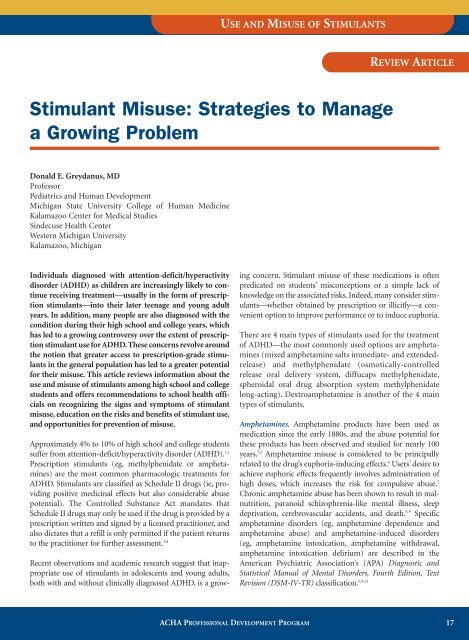
![Final Program [5.4MB pdf] - American College Health Association](https://img.yumpu.com/49022356/1/190x245/final-program-54mb-pdf-american-college-health-association.jpg?quality=85)


